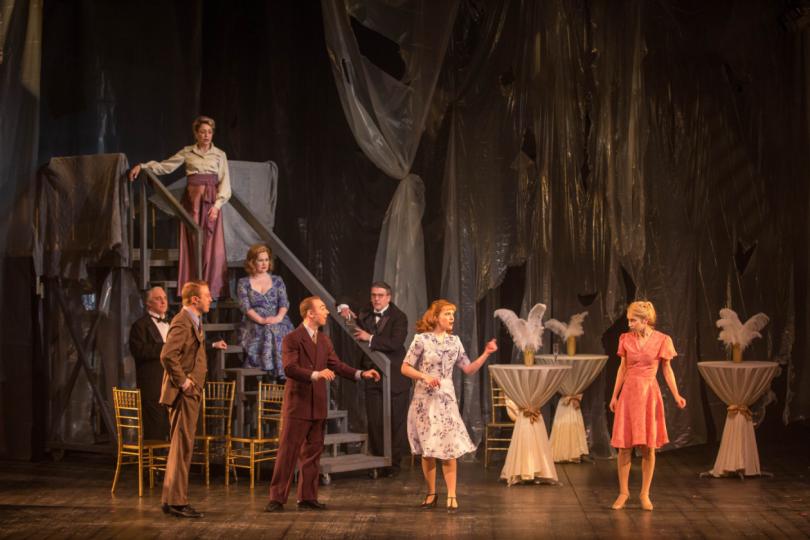Follies: The Third Definition

Folly is a great word, and it makes for a great title, because it means at least three things. First, follies are silly or foolish things. Second, they are a particular kind of theatrical revue popular in the first half of the 20th century. Third, and by far my favorite, are the structures built by English landowners during the Romantic period. These fake but picturesque ruins were meant to enhance the beauty of their parks and walks. Built to impersonate old hermitages or ruined towers, these "follies" trafficked in sentimentality and nostalgia. While there are showgirls aplenty, complete with gaudy feathers and glitzy dresses, the characters in Stephen Sondheim (music and lyrics) and James Goldman’s (book) Follies are more akin to these ruins: each life is in some way unsatisfactory, and everyone seems to be pining after different roads they could have taken. An unreflective date-night this is not, and I would expect many people leave with a sense of longing for their younger, unencumbered selves. I certainly did.
The musical centers around the unhappily married aging couples Phyllis (Wendy Short-Hays) / Ben (Bradley Greenwald) and Sally (Caitlin Burns) / Buddy (Paul R. Coate). Ben and Phyllis have it all -- money and power -- but his philandering and her self-sublimation have created a lifetime of shared bitterness. Buddy has not provided for Sally in the way she wanted, and she constantly holds him to the imagined standard of Ben (who, it transpires, she and other follie girls had romantic liaisons with). Around these central pairs, fleets of aging and elderly show girls confess similar dissatisfaction with their current lives. It is hard to know if everything is really as bad as people seem to think -- they are unreliable and provide a rosy lens on the past that only the unhappy present can furnish.
Meaty roles
Follies is rarely produced because, though its aim is to be the complete package -- story, pathos, song, dance, visual splendor -- in reality it is more than a bit messy. Its double-casting and fluid timelines don’t always work, and the second act, while a wild ride, doesn’t really add any new information. Artistry’s staging falls prey to the common pitfalls associated with Follies, but will leave you breathless during its more successful patches. Perhaps the best part is how self-aware the musical is: filled with characters who age but never want to give up the limelight, it provides a glamorous vehicle for a large cast of actors who do not always get much stage time in musicals. Watching Follies reminds you how few meaty and interesting roles there are for older performers (particularly women, particularly en mass). Like their characters, Artistry’s cast is talented and just wants to hold onto the spotlight for a bit longer. Most of the cast gets at least one show stopper, and while some numbers are more successful than others, all the performers are wonderful singers. Stand out performances include Diana Wildes’ “I’m Still Here” and Wendy Short-Hay’s “Could I Leave You.” Wildes is beyond charming, her smiling eyes and ingratiating manner are a lovely addition to the cast. Her version of “I’m Still Here” was poignant and wry with just the right amount of self-deprecation and humor. Short-Hay brings a bitterness and macabre delight to her stinging number.
While the music (both the singers and the pit musicians) was excellent, I could have done with a bit less swaying and a bit more actual dancing, especially in the first act. As Follies is basically song after song strung together with comparatively little dialogue, more choreography would have been welcome. The choreography in the showgirls’ solo songs points to a lack of faith in their abilities, or a lack of clear direction, or both, which is rather silly when you consider that nearly everyone is still able to tapdance! This problem was rectified in the second half, where most numbers were more tightly choreographed and necessarily more engaging. I was drawn to You’re Gonna Love Tomorrow/Love Will See Us Through, which really showed off the dancing prowess of Rebekah Meyer, Michaela Shapiro, Christian B. LaBissoniere and Riley Parham, and Short-Hays sparkles along with her harem in The Story of Lucy and Jessie.
Fashionable hierarchy
Eli Sherlock’s set is a bit drab in the first half, but explodes in gaudy splendor in the second half. The costuming really sets this staging apart, and Ed Gleeman should be commended. He does not shy away from the way bodies look as they age, but instead has found items that flatter each of the women as well as connoting their different lives and relative socioeconomic statuses. The costumes, almost more than the script, teach and reinforce the pecking order within the follie girls’ ranks. Sharp Phyllis’ voluminous pink dress pants with high-neck ruffled shirt look like elegance personified -- she is more powerful than the rest, and wishes them to know it. This repressed poshness is replaced in the second half by an insanely hot red flapper dress. Slightly matronly, Sandy’s sweet empire day dress is perhaps too informal and a little too worn for the glamorous reunion, but you can tell she picked it because it makes her feel more beautiful than anything else she owns. In the second half, she rocks a slinky torch dress that clings to her curves perfectly. Carlotta Campion’s form fitting red dress with black lace and flared skirt points towards a life geared towards impressing men, and underscores her precarious position amongst these women. Such loving care over these details helps these characters come alive.
While Follies is almost needlessly sentimental, it is wonderful to see Artistry attempt this convoluted and messy ruin of a show. Their efforts yield beautiful music and interesting character studies. Whether you want mistakes, musical revue, or a poignant picture of the ruined human condition, Follies has you covered.




